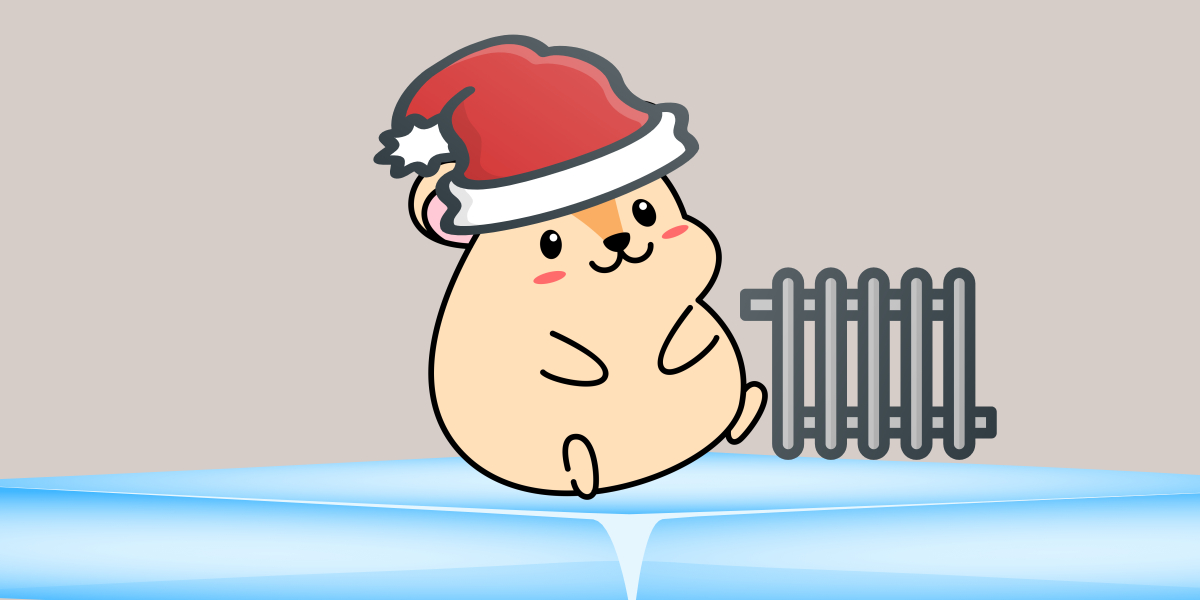Hamsters originate from temperate and arid climates in countries like Syria, Pakistan, India and Greece. Their natural environments don’t have incredibly cold winters, nor incredibly hot summers.
The ideal temperature for hamsters is above 60 degrees and below 80 degrees Fahrenheit. Temperatures outside of this range could be uncomfortable, or even dangerous, for your hamster.

Below, we’ll discuss why mild temperatures are important for hamsters, as well as different solutions for creating a warm and cozy hamster cage in the winter.
Contents
Why Should You Keep Your Hamster Warm?
Cold temperatures make hamsters more susceptible to illness and elevated stress levels.
Hamsters are permissive hibernators, meaning they’ll only hibernate under extreme environmental conditions. If hamsters are forced into hibernation, they are in danger of starvation, dehydration or hypothermia.
Help your hamster stay cozy and safe during the winter months by taking precautionary measures.
Barriers to Keeping Your Hamster Warm in Winter
In a climate that has extreme winter cold, it can be difficult to maintain warm temperatures, even inside a house. You may encounter challenges like:
- Insufficient wall or window insulation
- Breezes or drafts coming from single-pane windows
- Balancing a warm enough home with expensive energy costs
- Power outages
There are ways to overcome these challenges to meet the health and wellbeing needs of your hamster. Let’s take a look at some popular options.
Ways to Keep Your Hamster Warm in Winter
Hamsters do best in mild-to-slightly-warm cage temperatures, but they also need that temperature to remain consistent. When temperatures fluctuate too much, it can be bad news for your hammy.
A combination of the following suggestions will give you the best results for keeping your hamster warm in winter.
Use Blankets
Insulating the bottom of the cage with a thick blanket will help raise the cage’s temperature a degree or two. Make sure the blanket lays flat. Then set the cage on top of the blanket, and wrap the edges of the blanket around the bottom few inches of the cage.
You can also try draping a blanket over the top of the cage. Just make sure there is still proper ventilation for your hamster.
Warm Up the Entire Room
Keep your hamster indoors and on a main floor of the house. Avoid garages, attics and basements, especially during winter months.
Keep the cage away from drafts and cold air. You can do this by adding plastic insulation (like this) to your windows and tucking rolled-up towels under your doors.
Use a space heater. Be cautious; don’t place the space heater right next to the hamster cage. Space heaters may not be the best long-term solution since they need to be turned off when no one is home.
Provide Extra Bedding and Nesting Options
Hamsters like to make their own warm places where they can snuggle up and sleep. Supplying your hamster with extra cage bedding, as well as nesting and tunneling tools like paper-towel rolls, will allow them to make their own cozy nooks.
You can also try providing extra hiding places or pre-made nests where they can keep warm.
Increase Activity Levels
Mammals use extra energy when they need to keep warm during the winter. Feeding your hamster larger food portions will allow them to give off more body heat.
Short exercise sessions several times each day will help your hammy stay warm more easily.
Handle your hamster regularly (if it doesn’t stress them out). It will keep them alert and active.
Install an Under-Cage Heating Mat
A heating mat meant for reptiles or small animals can be a great solution to consistently heating your hammy’s cage.
Make sure you use an indirect heat source, like an under-cage mat, rather than something like a heating rock that might burn your hamster if they touch it.
Install the mat on one side of the cage. That way, your hamster can move away from the heat if they want to cool off a bit.
Some heating mats come with automation. They will automatically turn on and off if the cage temperature is beyond the parameters you set. Automation is a great option for owners who don’t want to constantly check on the cage temperature.
What to Do If the Power Goes Out
Most of the above solutions involve using a power source. If your power goes out during the winter, you and your hamster both need to stay warm!
Since heat rises, the top floor of your house will stay warm the longest. Move the hamster cage there.
Keep your hamster active to maintain their body temperature. If they are comfortable being handled, pick them up frequently and rub them to stimulate body heat. You can also hold them close to your own body to help keep them warm.
If you’re also wondering how to keep your hamster cool in the summer time we’ve got some helpful tips for you.

